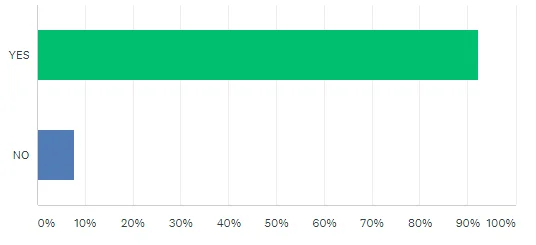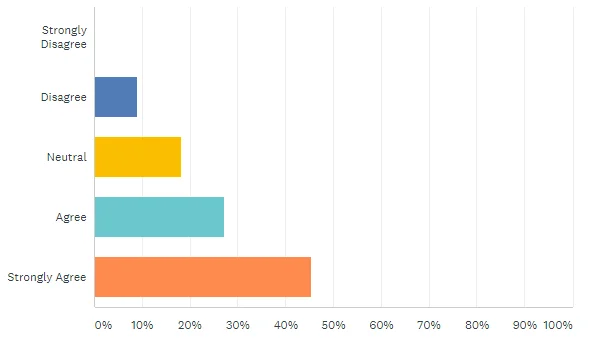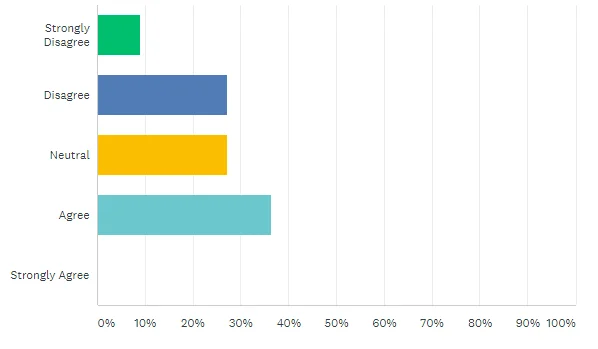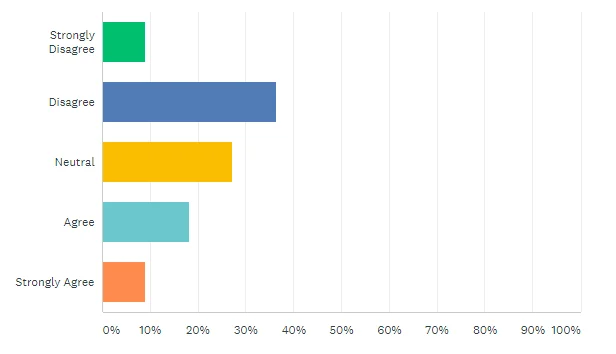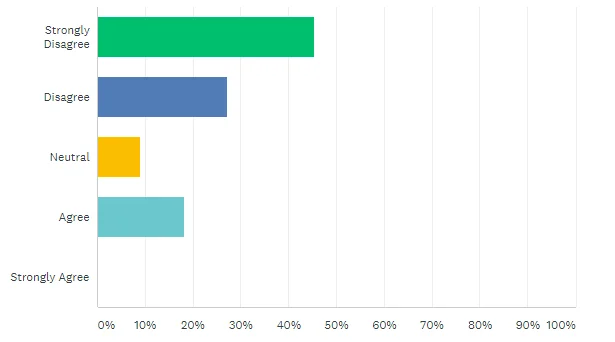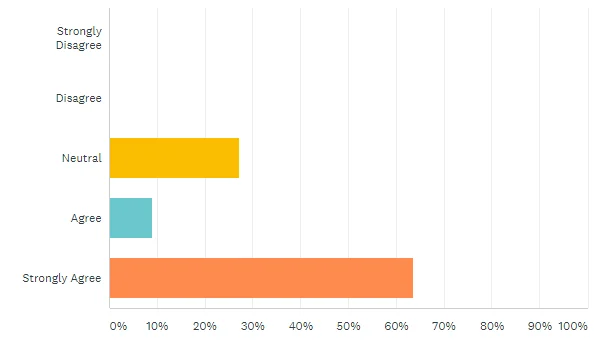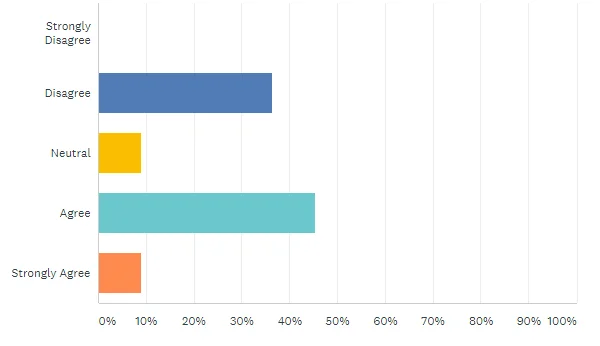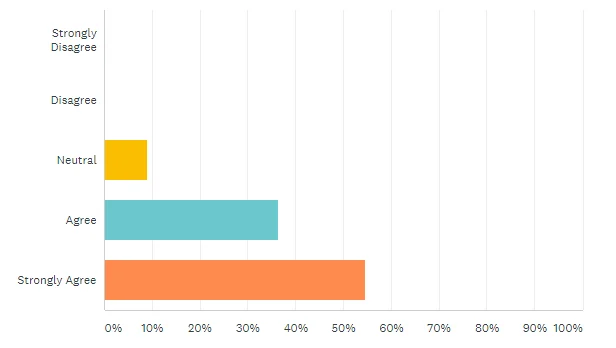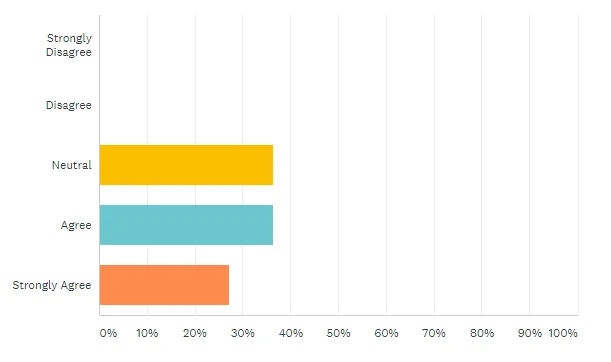Sample Project Management Results & Discussion Chapter
Here is a sample that showcases why we are one of the world’s leading academic writing firms. This assignment was created by one of our expert academic writers and demonstrated the highest academic quality. Place your order today to achieve academic greatness.
Chapter 4: Results and Discussion
Original Dissertation Topic: A Comparison of The Management Approach To Complexity, Uncertainty And Dynamism In Cognitive Systems And Traditional Information Technology Development Projects
4.1 Introduction
The purpose of this chapter is to offer the findings obtained through the use of questionnaire, which was based on Likert Scale (5-scale rating) to develop an understanding about the differences in artificial intelligence and traditional IT projects concerning complexity, uncertainty, and dynamism.
Even though, the questionnaire was distributed to a variety of individuals from the project management industry, only a handful of filled questionnaires were received by the researcher, which was further analysed through SPSS. Besides, 2 of the questionnaires were not taken into account for the analysis section, as the respondents intentionally left them blank; thus, it can be argued that inclusion of incomplete questionnaires could affect the research study’s overall validity and reliability.
4.2 Findings
This section has presented the findings of the questionnaire, which are as follows;
4.2.1 Frequency Analysis
4.2.1.1. Project Manager or Risk Manager of IT Project
In the questionnaire, the first question was focused on inquiring whether the participants were either project manager or risk manager; and to no surprise. The research findings indicate that approximately 92 percent of the participants were either project manager or risk manager in an IT project; however 1 of the participant replied with a ‘No’ suggesting that he/she had no relation to the post of project or risk manager. But participated in the questionnaire based on extensive knowledge about IT project. The graphical representation of the data obtained through the use of a questionnaire for the research study is as follows;
4.2.1.2. Artificial Intelligence Projects
When the participants were inquired about working on artificial intelligence projects, most participants (i.e. 8 out of 11) had never worked on artificial projects.
However it was also worth noticing that only 3 of the participants (representing 27% of the sample population) argued that they had worked on artificial intelligence projects.
It was also noted during the analysis of the questionnaire that 2 of the participants avoided responding to this question. The graphical representation of the data obtained through the use of questionnaire for the research study is as follows;
4.2.1.3. Use of Traditional Projects Tools and Techniques
When the participants were inquired about the use of traditional tools and techniques in project management, only 1 of the participant disagreed with the statement, which indicated that a variety of tools and techniques have been relied upon for the completion of projects in the participant’s company; meanwhile the majority of participants agreed with the statement.
It implies that the research participants or their companies have extensively relied on the traditional tools and techniques associated with project management to avoid any technicality and uncertainty associated with innovative project management tools.
Moreover, 2 of the research participants neither agreed nor disagreed with the statement. nThe graphical representation of the data obtained through the use of questionnaire for the research study is as follows;
4.2.1.4. Evolution of Project Management Methods
When the participants were inquired about the evolution of their project management methods, it was noted that 4 out of 11 participants disagreed with the statement.
It indicates that their project management methods have not evolved with time, and that their project management methods were regarded as standard in the completion of projects.
On the contrary, 4 of the participants agreed with the statement indicating that their project management methods have evolved with time. The methods change from time to time, and from project to project; thus the project management methods cannot be considered standard.
However, the researcher also observed that 3 of the participants remained neutral concerning the evolution of project management methods, which can be argued that they had limited knowledge about the companies’ project management methods for the successful completion of the projects. The graphical representation of the data obtained through the use of questionnaire for the
research study is as follows;
4.2.1.5. Reducing Uncertainty and Complexity through Modified Tools
The purpose of this question’s inclusion, in the questionnaire, was to determine how the project managers have reduced uncertainty and complexity in their projects.
In this regards, the researcher found that 5 out of 11 participants indicated that complexities and uncertainties in the project were reduced through the use of modified tools and techniques to the successful completion of projects; on the contrary, 3 of the participants also indicated that uncertainty and complexities were not reduced through the use of modified tools and techniques.
The responses also indicated that the participants relied on traditional methods, tools, and techniques to reduce
complexities and uncertainties before, during, and after the completion of the project.
Besides, it was also worth noticing that 3 of the participants remained neutral, which implies that they neither agreed or disagreed about the use of modified tools and techniques to reduce uncertainty and complexity in projects. The graphical representation of the data obtained through the use of questionnaire for the research study is as follows;
4.2.1.6. Measuring Uncertainty and Complexity
When the participants were inquired about measuring the complexity and uncertainty in project, it was found, based on the responses obtained, that 8 out of 11 participants disagreed with the statement, which indicated the importance of measuring uncertainty and complexity in projects.
Moreover, it also indicated that the project managers and risk managers were continually measuring the uncertainty and complexity associated with the project to avoid additional costs and time, which might have resulted in the delay with respect to the completion of the project.
On the contrary, it was worth noticing that 2 of the participants agreed with the statement that projects were initiated without measuring the complexities and uncertainties associated with the projects; meanwhile 1 of the participant remained neutral when inquired about the measurement of complexities and uncertainties. The graphical representation of the data obtained through the use of questionnaire for the research study is as follows;
4.2.1.7. Impact of Uncertainty and Complexity of Project Outcomes
When the participants were questioned about the impact of uncertainty and complexity on the project’s overall outcome, 8 out of 11 participants (representing 73 percent) argued that complexity and uncertainty negatively affect the overall outcome of the project.
In particular, it can be argued that uncertainty and complexity not only increases the overall costs and time associated with the project, but it also reduces the feasibility and reliability of the project to a significant extent.
On the contrary, 3 of the participants remained neutral for the question, which indicates that they were not sure about the negative or positive effect of complexity and uncertainty on the projects’ overall outcome. The graphical representation of the data obtained through the use of questionnaire for the research study is as follows;
4.2.1.8. Project Management Approach and Complexity/Dynamism
When the participants were asked whether they or their companies prefer using the same project management approach irrespective of the perceived level of complexity and dynamism.
It was found that 6 of the participants agreed with the statement. Considering the number of responses agreeing to the statement, it was quite confusing about using similar approaches for project irrespective of the perceived level of complexity and dynamism. it could result in the project’s overall failure, not to mention the costs and time allocated for the successful completion of the project.
However, it was also found that 4 of the participants disagreed with the statement, which indicates that project managers and risk managers are more interested in determining the most appropriate and feasible approach to project management by taking account of the complexity and dynamism concerning the project. On the contrary, 1 of the participant remained neutral (i.e.
neither agreed nor disagreed with the statement).
The graphical representation of the data obtained through the use of a questionnaire for the research study is as follows;
Receive feedback on language, structure and layout
Professional editors proofread and edit your paper by focusing on:
- Academic style
- Vague sentences
- Grammar
- Style consistency

4.2.1.9. Reduction/Elimination of Complexity and Uncertainty through Management
When the participants were inquired about the role of management in reducing and eliminating complexity and uncertainty in the projects, it was found that 8 of the participants agreed with the statement.
It indicates the significance of management in completing the project, while ensuring that the complexities and uncertainties associated with the projects are either eliminated or reduced to a significant extent.
On the contrary, 3 of the participants were found to have responded by remaining neutral in the question. The graphical representation of the data obtained through the use of questionnaire for the research study is as follows;
4.2.1.10. Documented Risks and Mitigation Plan
Concerning the documentation of risk, when the participants were inquired about whether the known and unknown risks were documented, it was found that 10 of the participants agreed that both known and unknown risks were documented within their organisations.
Furthermore, they also agreed with the fact that project managers and risk managers were assigned for the documented risks, where the assigned individual was responsible for the development and approval of the mitigation plan. However, 1 of the participant remained neutral in this question as well.
The graphical representation of the data obtained through the use of questionnaire for the research study is as follows;
4.2.1.11. Identification of Dependencies
The last question was related to the identification of dependencies in the project, before its execution. In this regards, it was found that 7 of the participants agreed with the statement indicating that their organisations have continually focused on the identification of dependencies before the execution of the project; however it was also worth noticing that 4 of the participants remained neutral in this regard.
The graphical representation of the data obtained through the use of questionnaire for the research study is as follows;
4.2.2 Analysis of Variance (ANOVA)
ANOVA helped in the comparison of AI projects and traditional IT projects concerning complexity, uncertainty, and dynamism. In particular, it was revealed through ANOVA that AI projects are more complex, uncertain, and dynamic compared to traditional IT projects based on the fact that F value was significantly higher than F-crit value (i.e. 68.46 and 4.35 respectively).
Meanwhile, the P value was significantly lower than that of 0.05, which indicates that the hypothesis depicting AI projects to be highly complex, uncertain, and dynamic in comparison to traditional IT projects has been accepted.
| ANOVA | ||||||
| Source of Variation | SS | df | MS | F | P-value | F crit |
| Between Groups | 7.306644249 | 1 | 7.306644249 | 68.4620817 | 6.89886 E-08 |
4.351243503 |
| Within Groups | 2.1345083 49 |
20 | 0.106725417 | |||
| Total | 9.441152597 | 21 |
4.2.3. Interview Analysis
For the interviews, the researcher selected two of the project managers that had also taken part in the questionnaire. Following is a brief analysis of the findings from the interview sessions;
4.2.3.1. Difference between Traditional Project Management and AI Projects
During the interview session with two interviewees, it was revealed by both the interviewees, “AI projects are far more complex in comparison to traditional project management. For instance, AI projects are more capable of understanding and uncovering the insights through the use of algorithms that might take weeks for a team of project managers.”
Moreover, one interviewee also suggested, “AI projects are not just reliable, but they are also better in making recommendations based on the scenarios.” During the interview, when the interviewees were asked about the use of standard techniques for measuring and managing uncertainty and complexity.
It was worth taking into account that both the interviewees were using various techniques including; stakeholder analysis, critical path analysis, PERT method, and agile method for project management. In particular, it was revealed that understanding the
requirements and demands for the project, it was important in the industry to follow standard techniques; however companies have also relied on the use of other project management techniques for measuring uncertainty and complexity. In this regard, one of the interviewee indicated “agile project management has frequently been relied on by project managers based on the fact that it not just includes the internal stakeholders, but also focuses on efficiency and individualism.”
On the contrary, the second interviewee suggested the same “agile has become a necessity for project managers in the 21st century, especially for AI projects.” This was further supported by the claim of the first interviewee “agile project management technique has frequently been adapted by companies especially for the AI peculiarities. Since AI project requires the recruitment of employees based on their skill-set while taking account of the project-specific focus.”
For the difference between traditional IT projects and AI projects, both the interviewees agreed indicating, “AI projects are far more complex in nature in comparison to traditional IT project, and requires extensive knowledge and understanding without which the successful completion of the project is impossible.”
Also, the first interviewee suggested, “traditional IT projects have predefined scope, methods and time frames, which are to be completed based on the routinary cycle. However AI projects do not have a predefined process and can initiate from the planning phased to redefining the goals and objectives, and vice versa until the project is completed”.
4.2.3.2. Complexity in AI Projects and its Effect on overall Project Management
When the participants were inquired about the overall effect of complexity in AI projects on the overall project management approach, it was observed that both the participants had different opinions.
In particular, one of the participant indicated “complexity of the project determines the approach to be selected for the project; for instance, if a project is not complex and of limited scope, the project management team would focus on the use of PERT and stakeholder analysis techniques; however in case of complex projects, the project management team would rely on the use of complex approaches to ensure that the complexities are resolved in most appropriate manner”.
On the contrary, other interviewee held the position “irrespective of the complexities and nature of project, the project management approach would be the same.” The interviewee further clarified the statement by indicating that they have relied on same management approach and have successfully completed a variety of simple as well as complex projects based on the use of a variety of approaches, which not only helps in the identification of complexities, but also helps in the development of counter-measures for complexities.
When the interviewees were further questioned about the project management methodology in their organisations, the first interviewee suggested “the use of PMI and further indicated that it is amongst the most recognised global project management methodology. It relies extensively on the use of computer based tests that could be administered, irrespective of the geographical
boundaries and locations.” On the contrary, the second interviewee indicated “the use of APM in their organisation for projects, which the interviewee argued to be a pragmatic approach that relies heavily on the leadership and management of teams.”
4.2.3.3. Level of Uncertainty in AI Projects in comparison to Traditional Projects
When the interviewees were inquired about the levels of uncertainty in AI projects in comparison to traditional IT projects, it was agreed by both the interviewees “AI projects are far more complex in comparison to traditional projects; thus making them more complex and with higher level of uncertainties”.
However, it was further indicated that “traditional IT projects do have certain levels of uncertainties, but are easily resolved; whereas AI project requires more complex methods to resolve the level of uncertainties that eventually increases the costs and time associated with the completion of projects.”
Both the interviewees further indicated “a variety of tools and techniques are used for measuring and quantifying complexity; however the most commonly used technique was the complexity index (CI)”. The second interviewee, in this regards, discussed about the essence of the framework by arguing it to be a “tool that helps the project manager in the identification of the possible manifestation of complexity within the processes associated with the project, while ensuring that plans are developed to minimise the overall effects of complexities prior to, during, and after the completion of the project.”
4.2.3.4. Modification in Activities to Improve Success Ration of AI system’s Delivery
When the interviewees were inquired about the modification in activities during the initiation phase of project management, it was suggested by the first interviewee that the most prominent activities that are taken into consideration for AI projects as well as traditional IT projects included “the kick-off meetings, identification of the most appropriate project team based on the complexity and nature of the project, allocation of the resources that are required for the development of project plan, and the identification and acquisition of project management infrastructure.” On the contrary, the second interviewee indicated that no specific modifications are made in the initiation phase of projects for the successful delivery of the systems. However, the interviewee further indicated “modifications in activities are only made once the initiation phase is completed.”
4.3. Discussion
4.3.1. Research Objective 1
Considering the differences in traditional and AI projects concerning time and costs, the study found that AI projects are more time-consuming and require extensive capital to effectively complete the project.
In contrast, traditional IT projects need less time and costs compared to AI projects (Ramchurn et al., 2012). This is primarily based on the complexities and uncertainties in the AI projects, which are rarely seen in traditional IT projects (Haslum and Geggner, 2014).
Similarly, the AI project’s scope changes with the passage of time, even during the implementation phase, which requires extensive working to ensure that the recent technological advancement and infrastructure are included in the projects to reduce the level of uncertainties in AI projects.
However, the flexibilities in AI projects allows the changes in the overall system, while providing the team members to showcase their skills and competencies in finding the best alternatives (Ma et al., 2009); whereas traditional IT projects have limited scope thus reducing the overall level of complexities and uncertainties.
Since it has already been established in the literature review and research findings, the AI projects have fluid requirements, which implies that the requirements could change during the initiation phase as well as other phases; however the project managers working on AI projects are more inclined towards the development of project requirements based on the demands and needs of the stakeholders (Britos, Dieste, and Garcia-Martinez, 2008; Wagner, 2014; Nilsson, 2009).
This is significantly different from that of traditional IT projects, where the project requirements are clearly established during the initiation phase, and the further phases rely extensively on the project requirements as highlighted in the initiation phase.
4.3.2. Research Objective 2
The identification of the project management methods revealed that companies have relied on various methods, including Agile, Scrum, Waterfall, and Kanban.
However, the project management methodologies are relied on considering the overall complexity and uncertainty of the projects (Cervone, 2011). For instance, AI projects requires the use of more complex methods and approaches to ensure the completion of the project effectively and efficiently. In contrast, traditional IT projects are less complex in nature, which indicates that the level of
uncertainties in such projects is lower than AI projects (Wagner, 2014).
Moreover, it was also found during the research findings that a variety of methods and approaches were taken into consideration (i.e. a combination of different methods and approaches) to ensure that the projects are developed and completed within the given time frame (Burke, 2013).
However, the traditional IT projects based on their simplicity require the adoption of a single method or approach, making both the projects significantly different in terms of complexity and uncertainty, along with their characteristics (Schwalbe, 2015).
4.3.3. Research Objective 3
Considering AI projects and traditional IT projects, it was found during the literature review and research findings that AI projects are highly complex and require an in-depth understanding of the project and its underlying aspects based on uncertainty (Kanal and Lemmer, 2014).
Since traditional IT projects are simplistic, the level of uncertainty is significantly lower than the AI projects, which are far complex; thus increasing the level of uncertainty with respect to the change in the external factors (Krause and Clark, 2012). Moreover, the flexibility of AI projects also increases the level of uncertainty, which is rarely seen in traditional projects.
Traditional IT projects have a rigid process, and change is resisted amongst the employees; whereas the flexibility aspect focuses on getting the product right rather than following rigid structures; thus increasing the overall uncertainty level in AI projects (Osman, 2010).
4.3.4. Research Objective 4
With respect to uncertainty in AI projects, it was evaluated that uncertainty in AI projects is primarily due to the project’s uncertain goals and objectives, followed by the frequent changes made in the product before its delivery (Ramos, Augusto, and Shapiro, 2008). This eventually increases the overall uncertainty aspect in AI projects. Moreover, the paths to be considered during the completion of AI projects are based on the project manager’s skills and competencies, thus increasing the overall uncertainty aspect for other team members involved in the completion of the project (Wegner, 2014). Since changes are frequently made in AI projects according to the
client’s demand, it eventually increases the possibility of uncertainty in such projects.
4.3.5. Research Objective 5
Considering the complexity and uncertainty in AI projects, project managers have frequently relied on making a variety of modifications in activities associated with the initiation phase of the projects to ensure that it secures greater success throughout the project management (Shao et al., 2009).
For instance, the project managers capitalise upon their skills and competencies to identify the most appropriate project team based on the complexity and nature of the project, allocation of the resources required for the development of project plan, and the identification acquisition of project management infrastructure.
Moreover, they tend to further modify the activities by introducing flexibility and transparency aspect in the initiation phase (Tarokh, 2008). This ultimately helps overcome the uncertainty and complexity in AI projects before, during, and completion of the projects.
4.3.6. Research Objective 6
Following are some of the recommendations that could result in the overall success of AI projects through the reduction or management of complexity and uncertainty;
The use of variety of methods and approaches in AI projects, while ensuring that AI projects are stemmed from agility, innovation, responsiveness, and teamwork.
Since the projects’ approval increases the uncertainty in AI projects, this could be improved through the use of automated software, while ensuring fast approval of changes that could be implemented by smaller teams with a higher level of autonomy.
References
Babbie, E., 2015. The practice of social research. Nelson Education. Best, J.W. and Kahn, J.V., 2016. Research in education. Pearson Education India. Britos, P., Dieste, O. and García-Martínez, R., 2008. Requirements elicitation in data mining for business intelligence projects. Advances in Information Systems Research, Education and Practice, pp.139-150.
Bryman, A., 2015. Social research methods. Oxford university press.
Burke, R., 2013. Project management: planning and control techniques. New Jersey, USA. Cervone, H.F., 2011. Understanding agile project management methods using Scrum. OCLC
Systems & Services: International digital library perspectives, 27(1), pp.18-22.
Creswell, J.W. and Poth, C.N., 2017. Qualitative inquiry and research design: Choosing among five approaches. Sage publications.
De Vaus, D. 2013. Surveys in social research. Routledge. Eriksson, P. and Kovalainen, A., 2015. Qualitative methods in business research: A practical guide to social research. Sage.
Haslum, P. and Geffner, H., 2014, May. Heuristic planning with time and resources. In Sixth European Conference on Planning.
Kanal, L.N. and Lemmer, J.F. eds., 2014. Uncertainty in artificial intelligence (Vol. 4). Elsevier.
Krause, P. and Clark, D., 2012. Representing uncertain knowledge: an artificial intelligence approach. Springer Science & Business Media.
Frequently Asked Questions
To handle uncertainty and dynamism in cognitive systems, adopt probabilistic models, employ adaptive algorithms, use real-time data fusion, integrate feedback loops, leverage machine learning techniques, and embrace agile methodologies for continuous learning and adaptation.



